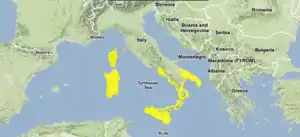Tyrrhenian-Adriatic sclerophyllous and mixed forests
The Tyrrhenian-Adriatic sclerophyllous and mixed forests is an ecoregion in southern Italy, Sicily, Sardinia, Corsica, the Dalmatian Islands of Croatia, and Malta.
| Tyrrhenian-Adriatic sclerophyllous and mixed forests | |
|---|---|
.jpg.webp) Ficuzza Reserve, Sicily | |
 Map of the ecoregion | |
| Ecology | |
| Realm | Palearctic |
| Biome | Mediterranean forests, woodlands, and scrub |
| Borders | Corsican montane broadleaf and mixed forests, Illyrian deciduous forests, Italian sclerophyllous and semi-deciduous forests and South Apennine mixed montane forests |
| Geography | |
| Area | 80,279 km2 (30,996 sq mi) |
| Countries | Italy, France (Corsica), Croatia, and Malta |
| Conservation | |
| Conservation status | critical/endangered |
| Protected | 16,489 km² (21%)[1] |
The ecoregion has a Mediterranean climate, and is in the Mediterranean forests, woodlands, and scrub biome.
Flora
The Tyrrhenian-Adriatic sclerophyllous and mixed forests has four major plant communities.
- The Tyrrhenian mixed oak forests are dominated by the sclerophyllous evergreen oak Quercus ilex and Quercus suber, and by deciduous species such as Quercus pubescens, Fraxinus ornus, and Ostrya carpinifolia.
- Some surviving temperate deciduous oak woodlands, mainly of Quercus robur, appear in coastal wetlands on the Italian peninsula and on the island of Corsica. Stone pine Pinus pinea is found on some coastal sand dunes.
- The southeastern Italian woodlands, in the region of Apulia, contain the oak species Quercus trojana and Quercus macrolepis, endemic to the Eastern Mediterranean, together with the evergreen holm oak (Quercus ilex) and the deciduous oak (Quercus pubescens). The Aleppo pine Pinus halepensis is also found in these woodlands.
- The islands of Dalmatia are dominated by Aleppo pine (Pinus halepensis) and holm oak (Quercus ilex). A relict and endemic subspecies of pine, Pinus nigra dalmatica, also occurs.
Fauna
Two subspecies of large mammal herbivore, the European mouflon (Ovis aries musimon) and Corsican red deer (Cervus elaphus corsicanus), are endemic to Corsica and Sardinia.
Protected areas
16,489 km² (21%) of the ecoregion is in protected areas.[2]
External links
| Wikimedia Commons has media related to Tyrrhenian-Adriatic sclerophyllous and mixed forests. |
- "Tyrrhenian-Adriatic sclerophyllous and mixed forests". Terrestrial Ecoregions. World Wildlife Fund.
References
- Eric Dinerstein, David Olson, et al. (2017). An Ecoregion-Based Approach to Protecting Half the Terrestrial Realm, BioScience, Volume 67, Issue 6, June 2017, Pages 534–545; Supplemental material 2 table S1b.
- Eric Dinerstein, David Olson, et al. (2017). An Ecoregion-Based Approach to Protecting Half the Terrestrial Realm, BioScience, Volume 67, Issue 6, June 2017, Pages 534–545; Supplemental material 2 table S1b.
This article is issued from Wikipedia. The text is licensed under Creative Commons - Attribution - Sharealike. Additional terms may apply for the media files.